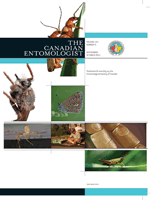Although human-modified landscapes are characterized by the loss of natural habitats, new habitats also can be created and exploited by many species. The importance of landscape change to invertebrate associations (particularly host-parasite associations) is under-studied. Our objective was to determine whether prevalence and intensity of gregarine parasitism in the damselfly Ischnura verticalis (Say) (Odonata: Coenagrionidae) differed between 17 artificial and 7 natural wetlands in landscapes that varied in amount of forest and wetland cover and road density determined at spatial extents of 500 m and 1 km from each wetland. Wetlands were located in and around Ottawa, Ontario, and Gatineau, Quebec, Canada. Wetland type did not account for significant variation in principal components based on forest and wetland cover and road density at either spatial extent. Gregarine prevalence was higher in damselflies collected from natural wetlands than in those collected from artificial wetlands and was positively associated with increasing forest cover. In contrast, gregarine intensity was inversely related to road density. Our results suggest that parasitism of damselflies by gregarines is associated with wetland type and landscape characteristics, although the mechanisms producing such relationships are unknown.
How to translate text using browser tools
1 October 2011
Relationships Between Gregarine Infection in Damselflies, Wetland Type, and Landscape Characteristics
Julia J. Mlynarek,
Daniel G. Bert,
G. Haydeé Peralta-Vázquez,
Joanna A. James,
Mark R. Forbes
ACCESS THE FULL ARTICLE
It is not available for individual sale.
This article is only available to subscribers.
It is not available for individual sale.
It is not available for individual sale.

The Canadian Entomologist
Vol. 143 • No. 5
October 2011
Vol. 143 • No. 5
October 2011




